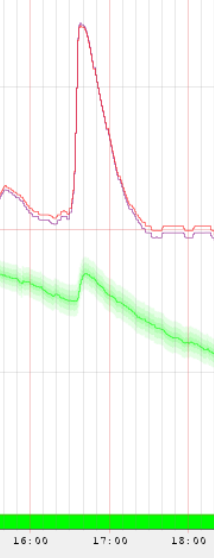|
|

|
 |
Here is an example of SID event correlated to the GOES measurements:
The red and violet lines correspond to GOES-10 and GOES-12 measurements of the x-ray flux. Event Start: The moment when an event begins. Be aware that the amplitude of different events varies considerably, and some may appear in inverted form. If it is obvious that an event began before the first definable start time, an 'E' (before) is appended to the recorded time. Event End: Of the three times, the end time is the most difficult to determine. It is defined as the moment when the trace returns to the diurnal trend line, or is interrupted by the onset of a new event. In the latter situation, the letter 'D' (after) is appended to that time, which in turn becomes the start time for the following event. Event Maximum: The moment when the ascending (descending in the case of inverted events) branch slows its sharp rise. Note that this generally does not coincide with the event's peak amplitude. If the trace goes off-scale as maximum is approached, or is interfered with in some other manner such as the onset of sunset, device failure, etc., we append a 'U' (uncertain) to the last identifiable time. For example, if the SID maximum occurs somewhere off-scale and the last determinable time is fourteen hours, ten minutes (1410), the time is recorded as 141OU. |
|
Importance generally refers to the length of an event, found by subtracting the start time from the end time. The table at right associates the Importance rating with event duration. With respect to the observer's typical daily trace, a class 1 SID is an event with small intensity change and a relatively short duration. Class 2 is a moderate intensity event with a fairly long duration, and a class 3 describes a SID with a 'great' change in intensity and long duration. |
|
| Definitiveness or Definition is a subjective estimate of an observer's confidence in the event. Normally, the events which are included in our reports have Definitions equal to 3 or greater. Use the right-hand scale as a guide to Definition. Careful study and experience teaches observers how to recognize false SID events caused by man-made interference. Beginners should not hesitate to assign high Definition values to those events which are not correlated with known noise sources. Other observers' results will be compared to eliminate suspect events before a final report is submitted to the NGDC. |
|
Note that the filename must respect the AAVSO requirements which are recalled here:
Data files must be named according to the observer and the station monitored.
Each observer has an ID code. i.e. A87
Each observer monitors a VLF station with a 3 letter call sign. i.e. NAA
The file name should reflect these two pieces of information: A87NAA.dat
|
SID Monitoring Station de Lionel LOUDET est mis à disposition selon les termes de la licence Creative Commons Attribution - Pas d’Utilisation Commerciale - Partage dans les Mêmes Conditions 3.0 non transposé. |
| Dernière mise à jour : 31 Aug 2014 |
|
Apache/2.4.65 (Debian) |
|